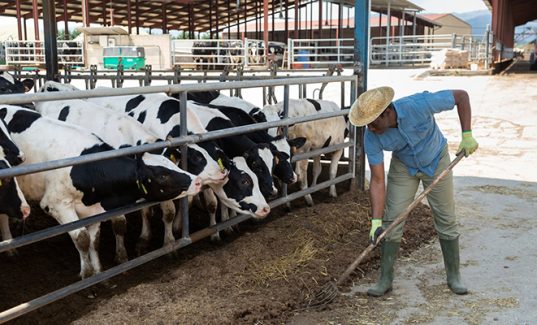Maybe it started when an infertile cow was seen licking and then eating dirt in a field?
Eating dirt was often associated with a phosphorus deficiency in cattle and somewhere along the line, phosphorus became associated as “a health and breeder mineral.” Consequently, feeding phosphorus to dairy cows, over and above their essential phosphorus requirement for maintenance, reproduction and milk production became the mainstay of dairy ration balancing.
It is now known much of this excess phosphorus ends up in the cows’ manure and can become a direct pollution threat to clean groundwater. Fortunately, sound dairy research advocates lower phosphorus levels in diets for dry and lactating dairy cows, making it more environmentally friendly while saving money.
Just how over-formulation of phosphorus in dairy diets really got started is anybody’s guess. Severe phosphorus deficiencies have caused “pica,” which is exhibited by cows’ abnormal licking dirt or chewing wood, bones, and rocks.
In less-extreme cases, failure to meet a lactating cow’s true phosphorus requirement is more likely associated with a subtle reduction in dry matter intake, followed by lower fibre digestibility and lower microbial protein synthesis by the rumen bugs. Unseen to the naked eye, a lack of phosphorus may cause a loss of energy metabolism at the cellular level. All good, but largely unsubstantiated reasons to ensure phosphorus requirements are met in lactating dairy cattle.
In contrast, the National Research Council recommends dairy diets have a maximum phosphorus level for all dairy cattle of 0.42 per cent, with average levels of 0.32-0.36 per cent for optimum reproduction and milk performance; and in a 2:1 ration with dietary calcium. This advice is about a 25 per cent reduction of the old phosphorus values found in more traditional dairy diets today.
NRC phosphorus requirements are based on three major scientific facts:
1. Reducing phosphorus to what the cow actually needs does not change a cow’s milk or reproductive performance, reports Larry Satter of the U.S. Dairy Forage Research Center, after reviewing three decades of research. He found phosphorus levels higher than current NRC recommendations did not improve reproductive performance in dairy cattle. Other studies showed similar results affecting milk production.
2. About 70 per cent of phosphorus is excreted in the cow’s manure (one per cent lost in urine and 29 per cent secreted in milk). A linear relationship exists between the amount of phosphorus fed over the above requirements and the amount dairy cows’ excrete. It was shown in one university study lactating dairy cows consuming 0.40 per cent, 0.45 per cent and 0.60 per cent dietary phosphorus on a dry matter basis will excrete 18 kg, 21 kg, and 32 kg of phosphorus per year, respectively.
3. Dairy cows are more efficient in conserving phosphorus by minimizing excretion in the manure, when phosphorus levels, closer to the cows’ NRC phosphorus requirements, are fed.
Such straightforward phosphorus nutrition in dairy cows is complemented by the underlying knowledge that about 50 to 70 per cent of total phosphorus in common forages and other dairy feedstuffs are bound as phytate phosphorus. This phosphorus is largely biologically unavailable to most single-stomach or monogastric animals (re: swine), but not so with ruminants/dairy cows.
That’s because active rumen microorganisms have the unique ability to break down phytate phosphorus and release up to 99 per cent of held organic P to the host dairy cow. In a similar fashion, inorganic rock sources of phosphorus (re: includes mono-ammonium phosphate, dicalcium phosphate, and defluorinated phosphorus) has about 95 per cent of bioavailable phosphorus.
Producers should be able to take advantage of dairy cow (and rumen bug) phosphorus (P) nutrition/digestion by first taking her respective phosphorus requirement and matching it with organic as well as inorganic phosphorus containing dairy feeds.
For example: An early-lactation high milk producing dairy cow needs a maximum of 0.36 per cent P in her diet (re: NRC) and assuming her dry matter intake is 23 kg; she needs a total 83 grams of dietary P compared to a traditional diet containing 0.48 per cent P and thus 110 grams of P.
An illustration of similar diets formulating dairy premixes of different levels of P are as follows (P values of feedstuffs in parentheses):
One of the best tangible benefits of choosing the low-phosphorus dairy premix versus the more traditionally P-formulated premix in that this sample diet would more closely match the established NRC (2001) phosphorus requirements, resulting in a significant cost saving. By reducing the amount of phosphorus by 27 grams fed to each cow translates into 128.5 grams of dicalcium phosphate (21 per cent phosphorus) that does not need to be formulated into the dairy premix or total dairy diet.
Since dicalcium phosphate costs about $800/mt, that translates to saving about $3,700 for a 100-milking cow dairy. Therefore, assuming it costs about $7/head/day to feed an average cow on the milkline that’s a savings of about 1.5 per cent of the lactation cows’ total grocery bill.
Supplying needed as opposed to surplus phosphorus not only saves money but also reduces the amount of phosphorus excreted in dairy cow manure, reducing the risk of phosphorus contamination of fresh water. In the end, it also might be a good idea that ground-licking dairy cattle eat this low-phosphorus dirt!
Source: Cattleman’s Corner




